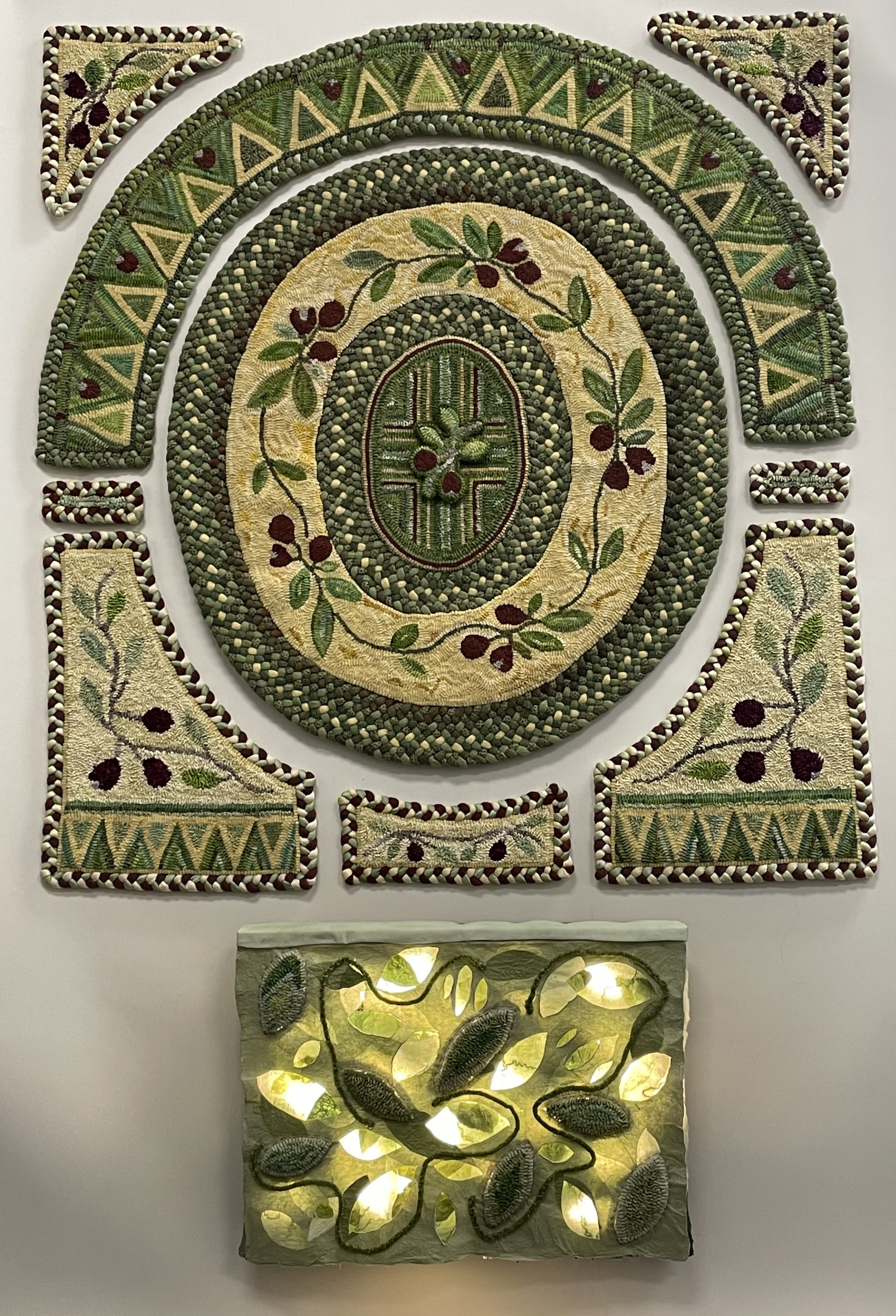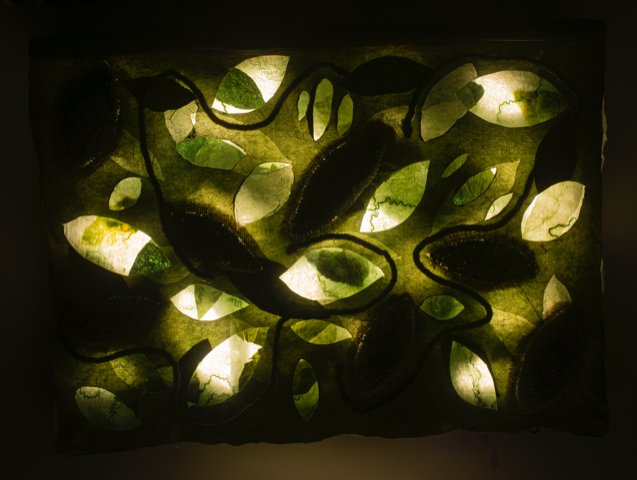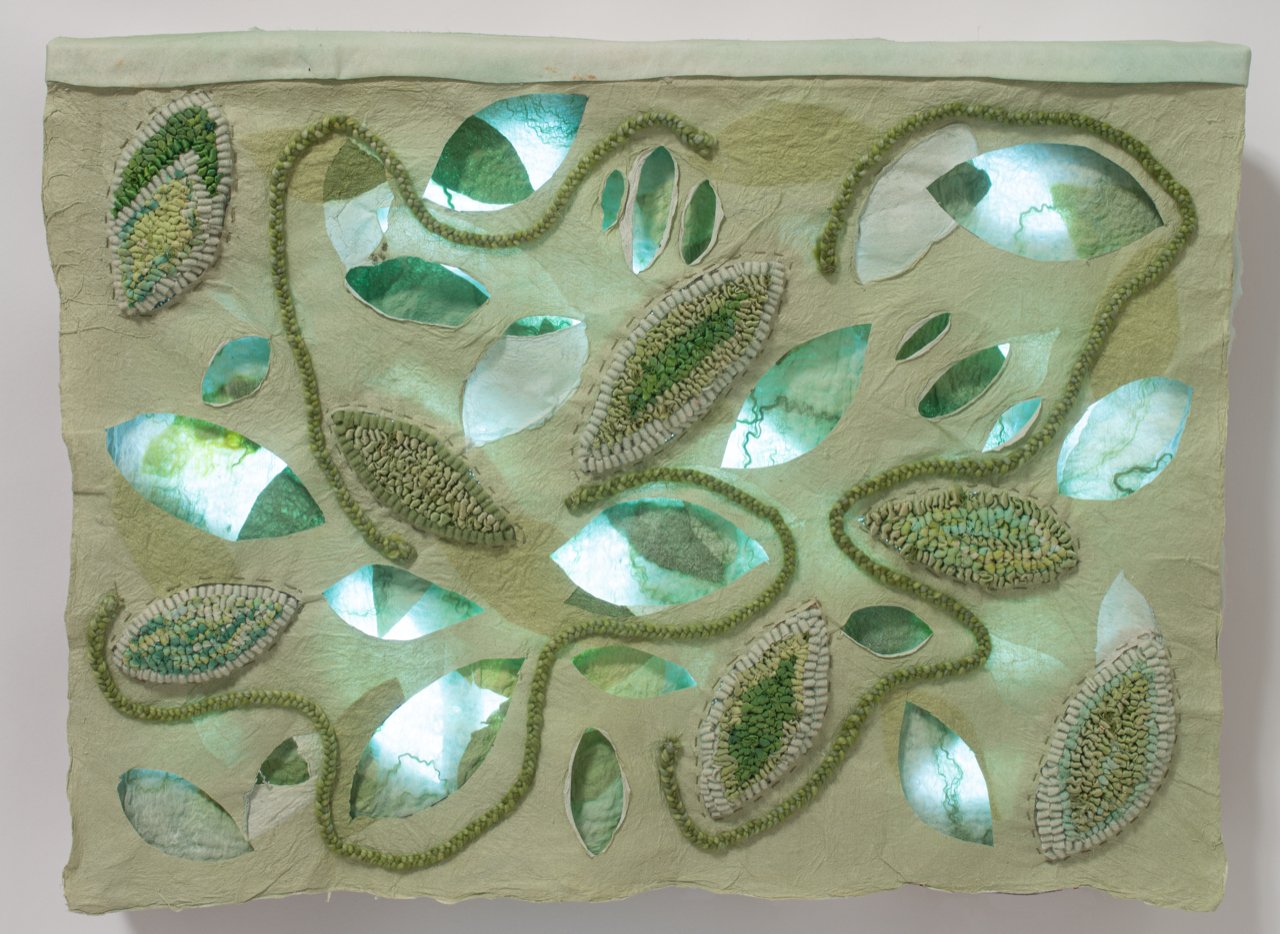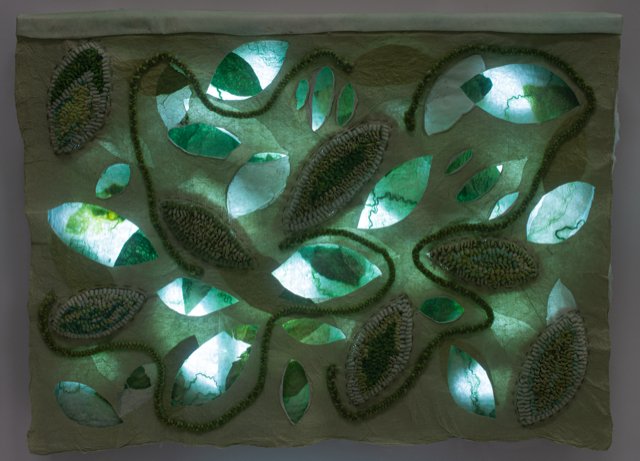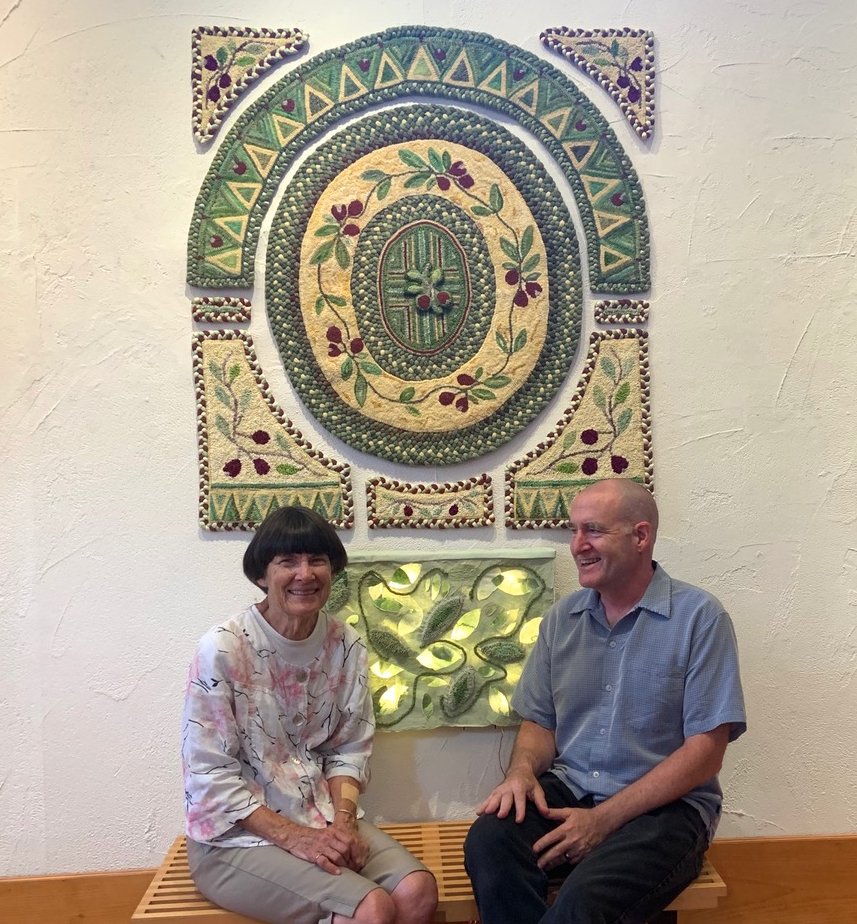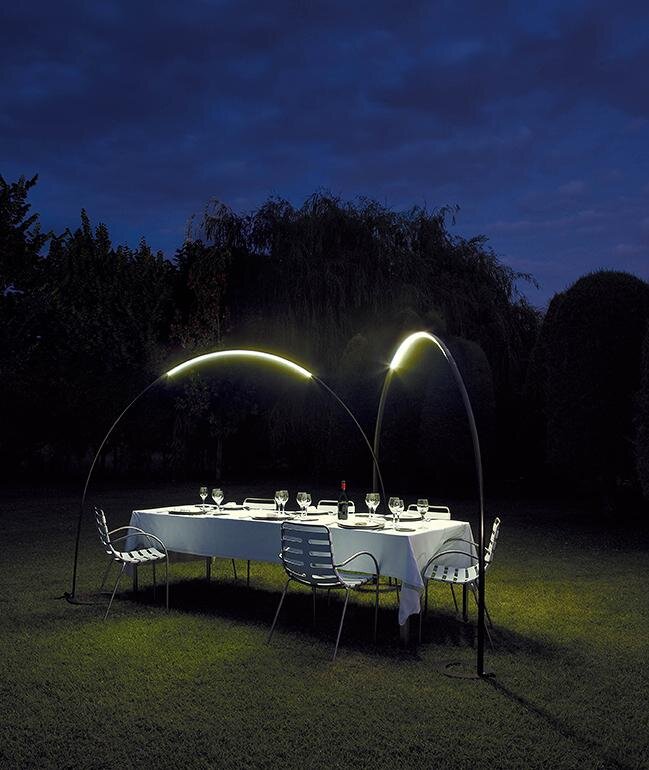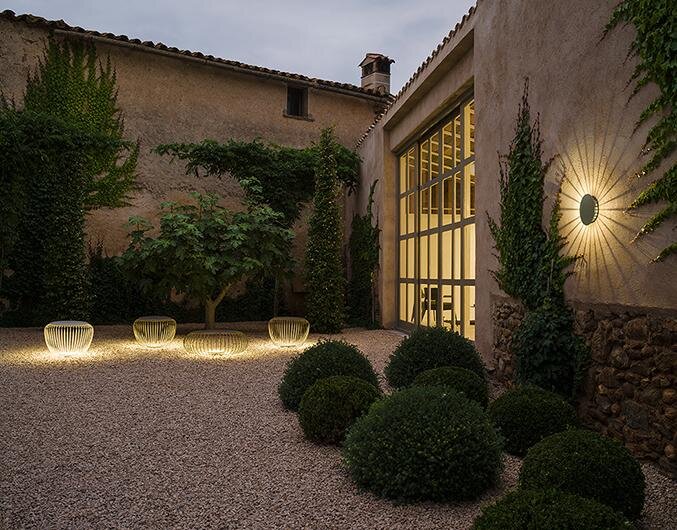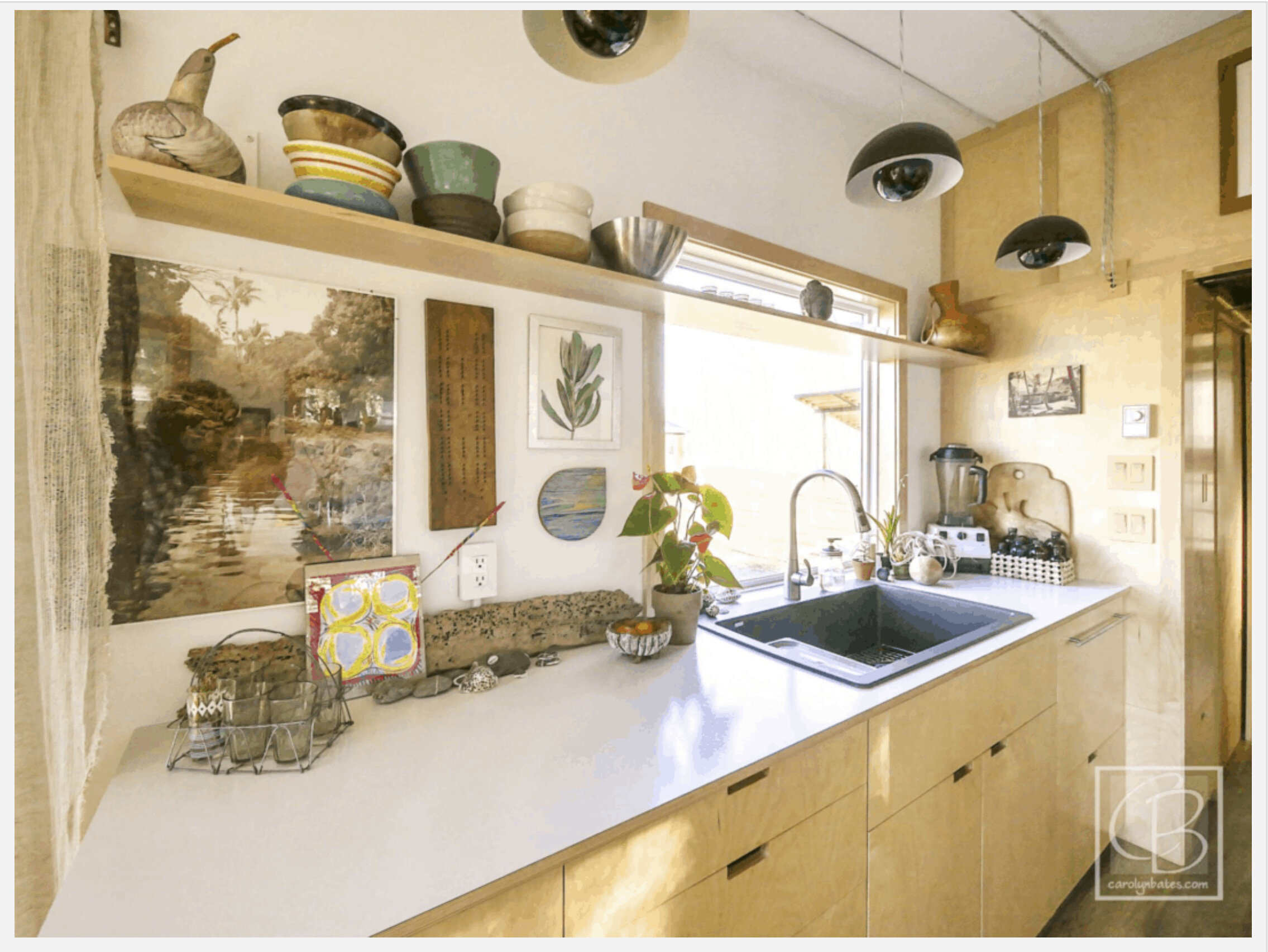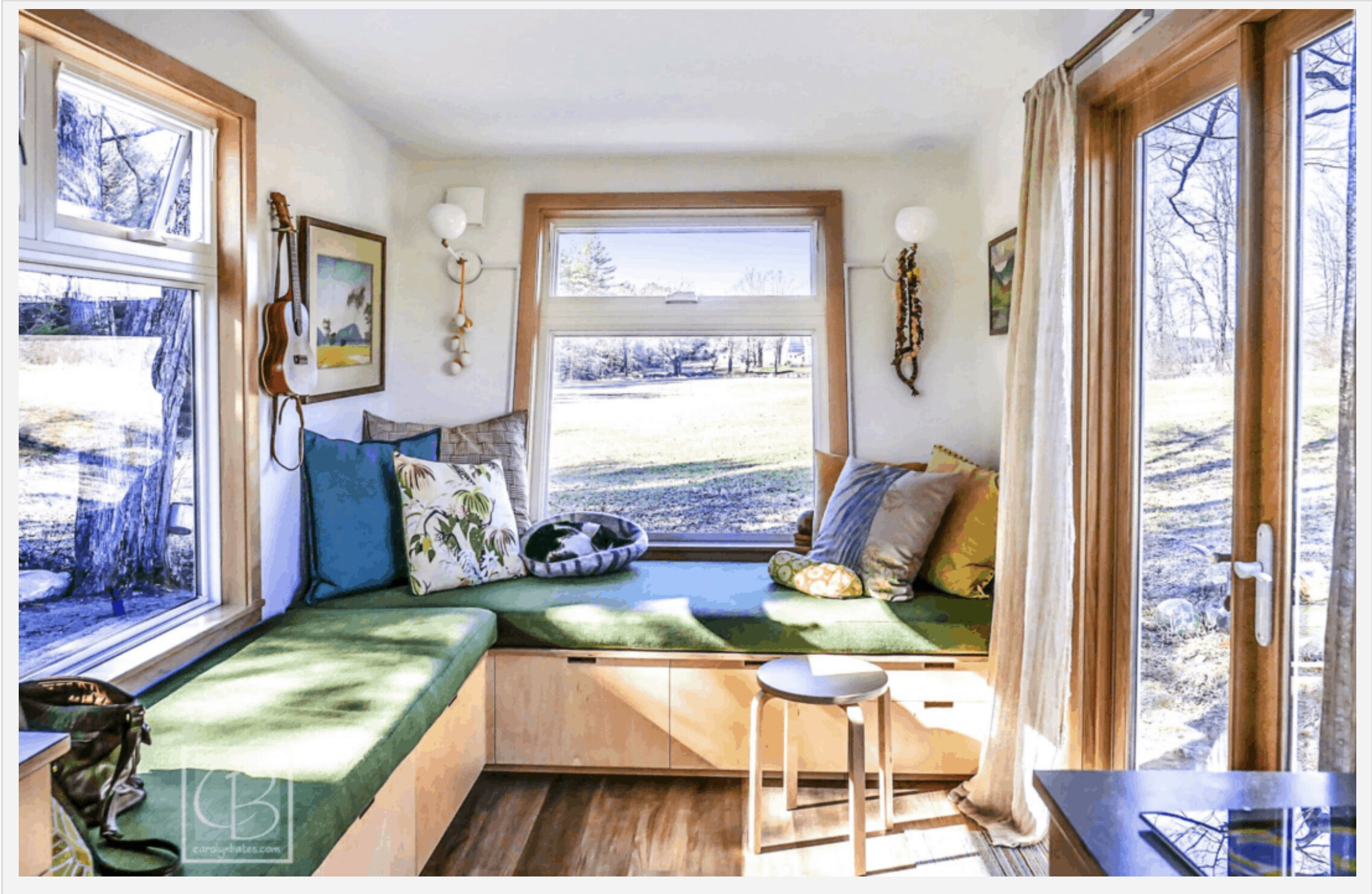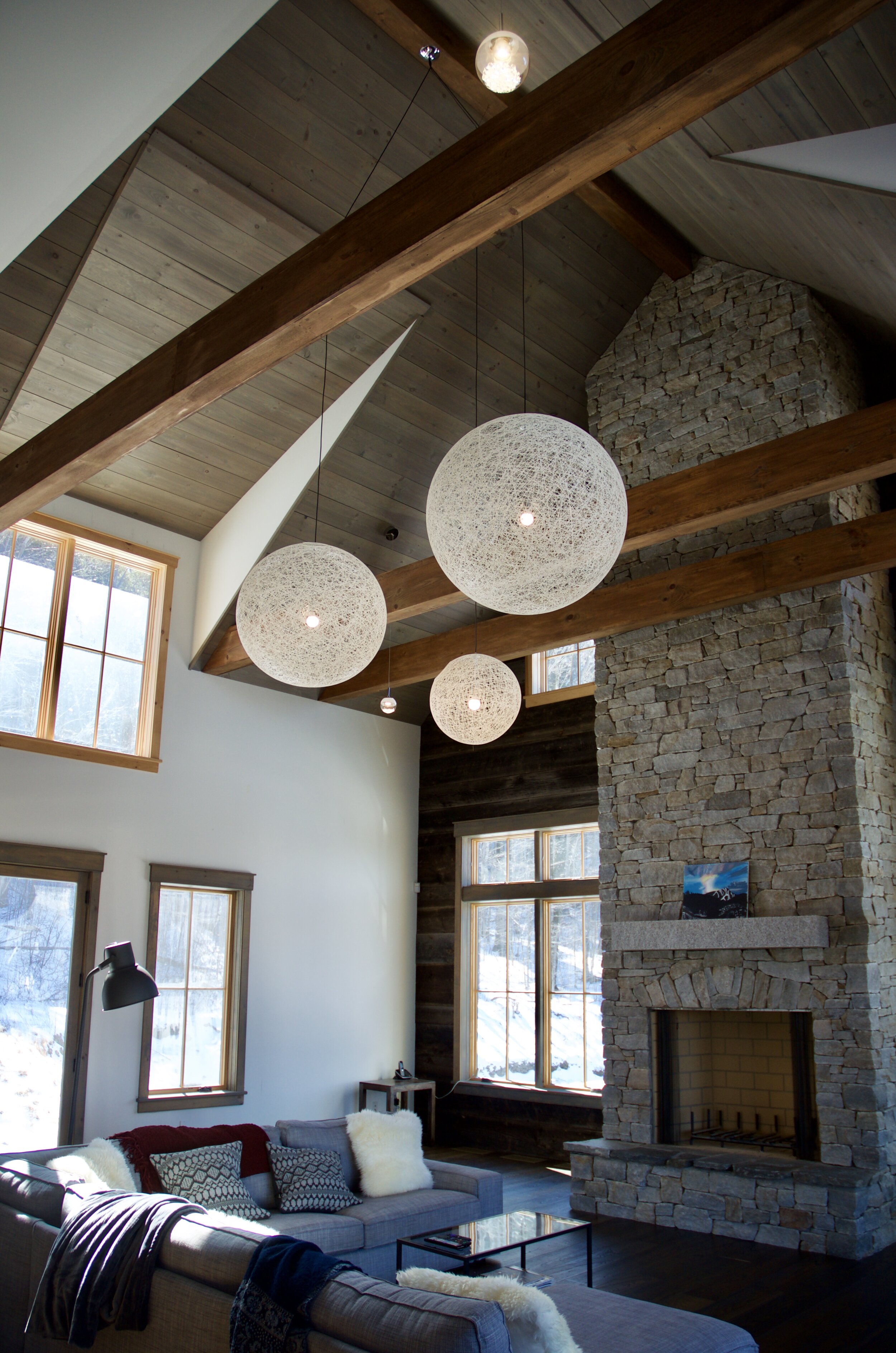Special Projects Collaboration
I have the great fortune to have many very talented and creative family members!
A fiber artist, a watercolorist, one art gallery lighting designer, a fashion museum curator, two animation specialists, and a musician. Yea, what a bunch!
I’ve been able to hang lighting for a couple art shows of some of their works over time, and more recently gotten to directly collaborate with my sister’s fiber art. Kris is internationally known for & teaches a unique combination of hooking & braiding rugs and hanging art pieces.
We’d discussed lighting one of her pieces for a while & on “Awakening“ it came together. Below the image is the Artists Statement, shown with the piece at each exhibit (in multiple regional & national events):
Awakening
2021
Hooked, Braided, Joomchi, LED Lights
Kris McDermet and Tim Mathiesen
I got the idea of the Leechee nuts from a platter I bought at the Brattleboro Area Hospice’s shop called Experience Goods in Brattleboro, VT. I loved the cranberry colored nuts and the greens of the leaves. Awakening started to be a rug for the floor but about a quarter of the way to completion, it became evident it was too light in color for muddy boots and animals! While hooking & braiding the center I realized I would never walk on it so decided to make it for the wall (the first moment of discovery!). Due to the weight of the braids, I decided to make it into multiple pieces and let my wall become part of the finished piece. There would be about 1.5 “ of air space between each piece with the walls considered just as important as the hooked & braided sections (another artistic piece-altering decision!). It grew to 10 sections but using the common theme of simple leaves and nuts throughout.
At the time I was working on the sections, I took a class in Joomchi* felting and made the decision to combine the Joomchi and the hooked & braided sections using the common leaf pattern as a base (now a third ‘ah ha’ moment! - now the name Awakening!). I had wanted to back light one of my fiber art creations and this seemed a fitting idea with my brother Tim Mathiesen who is a wonderful lighting designer. Awakening was taking shape over the winter of 2021 during the pandemic and stay at home orders. Our imaginations were developing and Tim began looking at how best to light the Joomchi elements.
After exploring how natural back-lighting enhanced the wonderful qualities of the hand-made paper, we settled on using a lightbox. The shallow depth of the box would utilize a ‘sheet’ of LEDs with layers of diffusion to help soften or smooth the light. My husband Stewart built the lightbox and we three figured out how to attach the Joomchi 3 layers of felting. The LEDs are ‘tunable’ white (they can be a warm, neutral, or cool white depending on the room setting) and we utilized a dimmer to have ultimate control of the lighting effect.
The lights make the felting shine and help to bring out the color of the wool and silk used in the hooking & braiding.
The effect of the entire piece needs the natural light (or overhead display lights) of the room plus the brilliance of the back-lit Joomchi.
* Joomchi is a “centuries-old Korean paper-making technique that uses water to seal several layers of thin, handmade mulberry papers together to form a single, strong sheet. The paper is first wet, then, aggressively gripped, grabbed, stretched, and manipulated until the fibers are broken down, or felted. A major transformation occurs: flat sheets of paper become a very organic, leather-like, almost living form.” from Susan Avishai
There is more collaborating in the works (lucky me!). See this post from @krisbraids on instagram for a sneak peek. As well, in the wings, we have a nice piece in the conceptual stage at this time, so stay tuned for that.
In Progress
Here’s a bit of what is going on (and is a bit of the cause for lack of posting)…
I’m just wrapping up a design consultation in western MA.
Property makeover where lighting & furnishings are getting updated to reflect the owners’ style. I was brought in to the project by the interior designer, wanting to provide her clients with the best lighting advice possible (many thanks to Susan!)
Getting to recommend & install wonderful custom fixtures from Shakuff, Rocky Mountain Hardware, Allied Maker, American Ltg. Trulux, etc.
Shakuff custom in the dining area.
Beginning a new project with clients of Peter Rose & Partners Architects of Boston MA. For a new SFR in southern VT, construction is just now getting underway. Clients & the project architects are looking for fixture options to adhere to a minimalist style, enhance the architecture, and not tax the budget - no mean feat!
As well, I’m currently crossing the finish line on two projects in central VT.
One is a lighting update to kitchen and living spaces. Homeowners desired nicer/better lighting to replace out-dated technology, and to add layers of light creating options during various uses within the spaces. Also adding hidden LED tape lights to spice cabinet and pantry to make choosing the right item a breeze.
The second is a new timber frame ADU. The interior designer on this one recommended me (many thanks to Sarah!), and we’ve been able to get custom Hubbardton Forge and SponnDesign pendants incorporated into the design.
Looking forward to seeing how these come together as they wrap up!
I’ll provide images as they become available.
I love my clients, the design partners I get to collaborate with, and the electricians/installers that make it all look good. I’m lucky & honored to have a part in this creative work!
Blog on Blogs & the Day of Light
Happy International Day of Light y’all!
The UNESCO International Day of Light is celebrated on 16 May each year, the anniversary of the first successful operation of the laser in 1960 by physicist and engineer, Theodore Maiman. This day is a call to strengthen scientific cooperation and harness its potential to foster peace and sustainable development.
With that in mind…
We all share good information, right?
By doing so we can only get better at what we do and we build a stronger community, right as well?
And isn’t our mission to get better design details out to our clients, about process, & about best practices, etc.?
In that vein, I present some of the best blogs that I visit regularly to get great information. Stuff that impacts my work, that provides details I need to make better lighting designs for you. No matter whether you are a homeowner or a design pro, you can appreciate how good lighting makes an important impact on life.
David Warfel: Founder @ lightcanhelpyou.com; he blogs here; member/contributor to ies.org; linkedin
J P Bedell: Find him @ deliveredlumens.lighting; his Day of Light vid; also a member of SDA Lighting; insta, twitter, linkedin
Candela Studio: They blog here; insta
We Have Launch!
The new site is live.
If you made it here, you already know this.
If this is your first visit, I hope you’ll have a look around and let me know what you think. I’m quite pleased with the outcome.
My design work would not be able to illuminate and look good without the collaborations with many talented architectural designers, interior designers, electrical contractors, general contractors, building crews and clients that understand the value of great lighting.
Hat-tip to my friend & web specialist Meg.
My sincere thanks to you all!
Feature / Statement Lighting to Enjoy
I have been thinking about this post for some time.
Occasionally I see some post / article in one of my feeds that attempts to codify the 'best' feature or statement lighting fixtures ever. If you're interested in lighting, you've probably seen similar articles. I tend to finish reading with some sense of disappointment. Though I've come to realize this is all quite subjective and varies through the eyes of the beholder.
My own selections therefore will be just that - my own, not some definitive list that each reader will agree with or select from.
To begin, it might be best to discuss what I believe a Feature or Statement light fixture is...
By definition, Feature can mean 'a distinctive attribute', and Statement can mean a 'clear expression of something'. Make sense so far?
Near the beginning of each design project, I ask my clients if they wish to feature a light somewhere. I explain this might be that fixture that makes one smile or feel joyful. It might be that special purchase made, or perhaps a stunning show piece or timeless classic. Maybe its something handed down & cherished. I want to find a way to properly incorporate that into the finished design for their space.
Here is one example of something special that qualifies as a feature: Clients had gotten two post lights from a favorite city park (that had been replaced / upgraded), we converted them to pendants and mounted them in the entrance hall to their new home. A feature unlike any other home.
So, a selection of my current favorites that I believe to be special:
Each time I have the opportunity to suggest / install one of these (and other unique items I find) into a finished design, I get a great feeling knowing I'm incorporating something special for the clients!
What are your own favorites to feature, fixtures you consider special, something that makes a statement? Let me know in the comments.
Tiny House Lighting
Prior to the first Tiny House Fest VT in 2016, I was hired to design a lighting layout for a THoW (Tiny House on Wheels) for Erin, one of the Fest organizers. There are now some images of the finished home. You'll see that just because the space is small, there is no need to skimp on style.
^ Outside, the small LED cubes over the deck provide up & down light without protruding past the roof overhang (so legally within limits for safe travel).
You can learn more about Erin & Kevin's THoW here. Listen to the podcast and view more images of this wonderful design.
All photos © Carolyn Bates Photography
Here are some additional ideas for lighting in Tiny Houses:
• LEDs are certainly the best overall way to light, as the most energy-efficient & power-miserly of currently available lighting technologies.
• LED tapes are thin and easy to hide, available in various color temperatures, tunable white, or in color-changing varieties.
• LED bulbs (for any screw-in type fixtures) from Cree, Philips, & Soraa are some of the best.
• LED 'wafer' (flat panel) fixtures give the look of a recessed fixture in 1" or less depth.
• Lastly, Kreon's Dolma fixture (a trio above) is an in-wall recessed fixture that can help to maximize THoW widths and stay within safe travel limitations. It can project both up & down lighting.
More New Project News!
I've been selected by the Windham Foundation to design lighting for the Turner Hill Interpretive Center in Grafton VT. This building is part of Vermont's African American Heritage Trail. While the Foundation continues their work on the Turner Homestead, the former Law Office (above, located at 31 Townshend Rd., Grafton, VT) serves to tell the story of the Alec Turner family and their part in Grafton's rich history. Alec Turner was an escaped slave who fought with the Union Army before settling in Grafton in 1872. He worked as a logger and sawmill worker until he saved up to buy 150 acres on a Grafton hilltop. There he built a home where he was to raise 13 children together with his wife, Sally Turner, a freed slave. His daughter Daisy tells the family's tales that line the Center's walls.
I hope to honor & enhance their story by bringing light to the Center for the first time.
Dwell - Good Reading
Recent work has been published by Dwell. Nice!
Happy to be part of a wonderful team of designers and trades that transformed an old VT barn into a high performance home. The architect chose to leave some of the barn's original elements within the existing structure, while updating finish materials and adding lots of windows for daylighting. With plenty of new wood lighting fixtures and many brightly painted surfaces, this home is warm, welcoming, and well-lit both day & night. This home appears in a larger article as the first of five barns & farmhouses that celebrate their roots.
Additional images may be seen in the Portfolio. All photos © Lindsay Selin Photography.
Exciting Project on the board!
Quite excited to be asked to collaborate on the design team for a church preservation / renovation / addition project!
Here is the early story of the project beginnings, of a local hero attempting to save a piece of history in her town. I loved reading about the early dreams they had for this place!
One portion of architect Robert Swinburne's initial thoughts on the project during his early design work:
"This is an old church begin turned into a modern home. My approach with this design is to minimally impact the large main space of the church. ... We are looking at a full height metal and glass separation from the large area of the church (from the residence addition) which will provide some acoustical changes, affect the heat distribution, lighting and provide a more intimate feeling for fewer occupants. Large sliding panels will allow this curtain wall to open up."
A short video made by the architect leading the design team, with glimpses of what the project will become!
^ We’re renovating this early 1900’s church…
...to this!
^ One of my early interior renderings of the view from the church’s main open volume to the new residence.
^ Here, the reverse view from the residence addition.
Further updates will be posted as it all comes together!
Happy Diwali!
Diwali is the Hindu Festival of Lights. One of the most popular festivals of Hinduism, Diwali symbolises the spiritual "victory of light over darkness, good over evil and knowledge over ignorance. "During the climax, Diwali revellers illuminate the interior & exterior of their homes with oil lamps or candles, worship to Lakshmi (the goddess of prosperity and wealth), light fireworks, and partake in family feasts where sweets & gifts are shared.
We could all use more of that. Just sayin'!
JLC's Energy Column - Good Reading
I'm pleased to be a part of the Energy column featured in Journal Of Light Construction's May issue, written by senior editor Ted Cushman. The column's focus is on 'high-efficacy lighting' and illustrates how code changes & LED technology improvements are coming together and making for some great lighting. A portion of my focus in the interview is that 'every project at every budget level deserves great lighting' and how 'we (as lighting designers) are free to design an entire house to use LED. That definitely has moved beyond what the 2018 code is talking about.'
You can download the PDF here.
Table Lamps Galore!
Along with my wife Robin, in our Mathiesen & Mathiesen Design partnership, we have just recently finished a photo shoot of Raku & Obvara (aka Baltic Raku) pottery table lamps & vases for ceramic artist Jenifer Morier @ LightenUpStudio.vt in Guilford VT. Jen is also on Etsy as JeniferMorierPottery.
Presenting here, a few of our favorite shots.
Raku is a type of Japanese pottery and Jen's works include crackle glaze, brilliant colors and hints of copper tones. Of Obvara, Jen says its "A centuries-old process where glaze-less pots are fired to 1650 degrees Fahrenheit then plunged into a fermented brew of flour, yeast, water, and sugar. Smells like burnt toast, in a good way."
I was able to consult on sourcing electrical supplies (cording, Edison bases, dimmers, etc.) The lamps are equipped with Cree & Philips LED A-lamp bulbs, most with dimmers, ready to dress up your tables for work & play!
Next up we're hoping to create sconces from new Raku pieces, stay tuned!
UPDATED June 2020: Jenifer has her Etsy shop online for purchasing. Please visit and check out her newest escapades into Saggar fired pottery, its fabulous!
Photometry
Photometry is the science concerned with measuring visual response to light, in terms of its perceived brightness to the human eye. Because the eye is a highly complex organ, this is by no means a simple task.
OK, that's a simplified definition, without the formulas & technical issues that drive the work.
Depending on your point of view, photometry is either the glamorous scientific side of a lighting designer's efforts to create great lighting OR the quite less-than-sexy work to make a design function correctly by providing the correct levels of light to meet a code or need. From either view, the resulting renders that are part of the engineering of photometry are both informative and cool.
Earlier this year I was asked to design an exterior lighting package for a restoration project of a city block in Bennington VT. Working with a design team of Stevens & Associates & the engineering firm of Dubois & King, we designed & engineered for public street entrances, rear building entries, two public courtyards and off-street parking & access ways. The final photometric renderings by Dubois & King illustrate the results beautifully. Bright entries that beckon you to approach & provide abundant safe lighting at sidewalks & steps, courtyards that invite you to hangout & relax in them, and parking with a relatively even wash of light. This was another wonderful collaboration, very happy to be a part of the teamwork!
Lighting The Way: Four Good Reasons Why You Need A Lighting Designer
Linking here to Stratton Magazine’s Fall 2017 issue with an article by Anita Rafael that I’m featured in: "Lighting The Way: Four Good Reasons Why You Need A Lighting Designer”. Please let me know what you think! It was a pleasure to be part of this and I am looking forward to a visit some day with Susan Brady @ SBLD Studio Architectural Lighting Design, the other designer featured in the article.
What Makes Good Lighting?
I begin with a caveat - This is an opinion piece.
First, I'd like to define what I mean when discussing 'Good Lighting'.
Good Lighting is timeless and long-lasting, it's innovative, it's unobtrusive, and it's environmentally friendly.
Good Lighting provides joy, safety, wellness, personal expression, unique character, and highlights detail in our spaces and in our lives.
Good Lighting creates a positive visceral response.
Before proceeding to work on any lighting design, the program (or concept) of the project is required for an understanding of the well-defined wants and needs of our clients. Good Lighting Design issues that then need to be considered include: What are we lighting and where to place light; What type luminaire (fixture) and lamp (bulb) to use; How to control it.
Ok. What makes Good Lighting?
There are a few key elements that will apply no matter what style is chosen and no matter the size or budget of a project.
• Create layers of light. Spaces are used in a variety of ways, the lighting should be flexible to allow that. Mixed sources will allow selections to be set to changes in mood or use.
• Use direct & indirect light. Work areas want quantities of task light directed to the surfaces. Ambient light gets washed or bounced off various materials.
• Incorporate shadow & asymmetric pattern. These are needed to provide contrast in a space. With that, we can appreciate the features, textures, and decoration.
• Hide the light source. Glare is the nemesis of good lighting. The trend to using bare bulbs is over-rated, and old-tyme-y edison bulbs do not provide enough quantity of lumens to be useful. More about this in a future post.
• Utilize advanced controls. In the simplest form, a dimmer instead of a switch. Perhaps add control of certain lamps via a smartphone app. A fully programmable & integrated system in a more extreme sense.
• Include a 'feature'. This can be that fixture that makes our client smile or feel joyful. It might be a special purchase or a cherished hand-me-down or show piece luminaire. Got ideas of your own about what makes Good Lighting? Please let me know, I look forward to hearing your thoughts.
Houzz.com, Thanks again!
From Houzz.com..."We're writing to let you know that you've been voted by the Houzz community as a winner of our Best of Houzz 2017 award! You can read the full press release here. Your work won in the Design category, as your portfolio includes some of the most popular images on Houzz in 2016."
Tiny House Festival VT Followup
As some may have noted from other postings, I was asked to give a presentation on Lighting & Interior Design for Small Spaces at the first Tiny House Festival VT in Brattleboro VT this fall. Here now, a copy of the talk I gave. I'm pleased with the message, & the reception from those in attendance, even while being somewhat rushed on time. While this AV edit is a bit rough, a hat tip & many thanks to BCTV for all their efforts under unusual conditions that day. I was also fortunate to be followed by Lina Menard of Niche Consulting, a tiny house design consultant from Portland OR. Another great take on tiny house design! Both talks have great information on design, no matter what size you're considering. Shout out to the festival organizers for a job well done. Onward to THFVT 2017!
What does that mean?
I am a Lighting Designer.
What does that mean (at least to me) and how could it benefit you?
As a lighting designer, much of my work is in 'atmosphere design'. In part this means planning how spaces (and the objects within) get illuminated & accentuated, about setting the tone or mood, and working at addressing the needs of the inhabitants & visitors. Mine is a collaborative design practice. It always revolves around you as the client and often includes Architectural Designer, Interior Designer, Landscape Designer, and Electrician. Like these professionals, I have years of educational and project experiences to bring to bear on any design challenge. I believe an added bonus for me is years of work in the entertainment arena (dance, opera, theatre, music concerts, and touring) which give me a bit of a different perspective. How we go about manipulating light and dark, incorporating day-lighting and shadow-play, choosing fixtures & materials, considering your (the client) personal choices, and the ‘big picture’ and overall design aesthetics are all elements of a successful project with an outcome you'll be pleased with for generations to come. Good Design is timeless.
Like many of the design team members mentioned, I work through a number of design phases covering everything from initial concepts to occupancy.
During design development I'll work on possible inclusion of the latest technologies to keep the project as current / future-ready as possible; I'll research best available lamping and use of color & tunable white lighting (more on color & tunable white lighting options in a separate future post); I'll consider any light (and sound - yes, some lighting emits sounds) sensitivity you may have; and we'll look at the overall style aesthetic for the spaces.
Further along the design path we'll have plenty of opportunity for dialog about what the lighting design / layout is going to accomplish, how the layering of light in the spaces will look, and about actual fixture proposals.
During design documentation I'll refine the fixture proposals, create the final design / layout and a fixture schedule to be used by the electrician to make fixture purchases and installation. The layout will specify fixture & switching locations, dimming functions, specific lamping for fixtures, applicable smarthome technologies, etc.
In the actual construction phase I work to address any electrician / contractor needs. As the project reaches completion, I'm available to work on a final focus of any adjustable lighting included in the project so that the design elements are fully realized as you move in. I also like to review the project objectives and get client feedback after you have settled in to your new space.
Everyone deserves good design and great lighting.
Please be in touch. Onward!
Sharing Clients' Love!
I do enjoy getting feedback of all types from all my clients, whenever it comes up. I really love when I'm invoicing my design work and get replies like these:
M.F. writes after our design work on a kitchen / pantry lighting design...
"...(the electrician) was here today and did the pantry lighting. Looks great. He will do the other (main) in mid April when the parts come in. Thanks so much for all your work and all your great ideas! So nice to work with you."
M.K. sent this message along as the project progresses with lots of 'too-long in the dark' artwork gets well lit:
"...considering how great it looks thus far. (the electrician) will be here today to finish it, you should stop on by sometime and see how good the paintings finally look now that we can actually see them! Thanks for your expertise, again!"
Everyone deserves great lighting, and it can be achieved at every level no matter the size of the project or the budget. Huge shoutout & hat-tip to Tim T., the electrician on these projects. I'm lucky to work with such a talented & easy-going contractor, who makes me look good while he does good work. Thanks all!
Technically Minded
Two very thoughtful technical articles linked here. Good reference material and additional resources.
The first an open letter from Jim Benya, where he "... urges the lighting community to focus its attention on LED lighting quality, lest a dangerous precedent be set that ignores color temperature and makes way for glare in the name of energy efficiency."
The second on new color rendering metrics and technologies that can only make our lighting design practices better.
